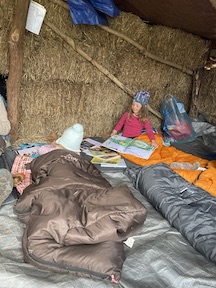By: Susan Kinsky
As place-based educators, we facilitate relationships: between people, with students, with community members, and with the places we study. I want to focus on emotional relationships and connections with places. I don’t think this is separate from gaining knowledge through observation, data collection, and research, but I do think the process is different. What does it mean to love a place? How do we create opportunities for our students to fall in love?

There was a tree in my backyard growing up in Omaha, Nebraska. I had a particular perch in this tree that was my refuge. My younger sister couldn’t quite get up there and my older sister wasn’t interested. There was a y-shaped bough that I could relax into and feel supported. It wasn’t all that high, but it was mine. It was a joyful scramble up followed by a moment of calm wonder. My best friend, Reshma, would ride her bike to my house and join me up there sometimes too, our shared place, slightly smug about our spot being unavailable to our shorter siblings.
I haven’t climbed a tree recently, but I experience moments of wonder while I walk my dog. My mind will be focused on tasks and chores then something changes. I suddenly become alert to the sound of the leaves rustling in the wind, the breeze on my skin, the smell of leaves beginning to rot, the beauty of the moment. It is in these moments that I gaze upon a tree and think, “we are connected, the same.” I can’t explain why these moments take hold and why they pass. My dog is much better at generating these sensory moments – as he takes time to sniff and sniff and sniff. He knows on a basic level how he is connected to the natural world as he pounces and rolls and zooms.
My 5-year old daughter spent the last two years in an outdoor classroom in which every part of the day was steeped in reverence for and play with the natural world. Her base camp was not in a park or the woods, but just outside the gates of the North Campus Children’s Center on UM’s campus. They rested in a sturdy structure made of branches, tarps, and bales of hay under a mighty maple tree, lovingly called Mama Maple. Mama Maple was their shade, their meeting place, the tree they tapped, and their teacher.
In my anecdotes, I notice a sense of wonder, the presence of play, and an unrushed, unplanned quality. Even though schools are typically rushed and our time limited, I know that we educators are geniuses at creating opportunities, at excavating the margins, at planting seeds. I also know that students’ relationships with the places of PBE are worthy of our attention. So, here are some questions and relationships that I have been chewing on and I invite you to do the same:
- As we launch a study of a place, how can we cultivate students’ love of and emotional connection to that place? What are they feeling and can we help students make sense of and name those feelings?
- How can we make it even more joyful? How does joy lead to and support stewardardship?
- How might play fit into our work? Do opportunities for unstructured play impact students’ relationships with a place and with their community?
- How is facilitating this different for teachers who work in urban, suburban, and rural settings? What can we learn from one another?
- Why not look to our colleagues that teach in outdoor classrooms for guidance?
There is incredible wisdom and experience in our coalition. My mind is swirling and I wonder if we might make space to think and learn together. Please reach out if you are interested in being a part of this conversation and I’ll set it up. And I know just the place – under Mama Maple.

Susan, this is a beautiful piece! I love how you name educators as “facilitators of relationships” and yes, wonderful questions to ponder. Thank you!